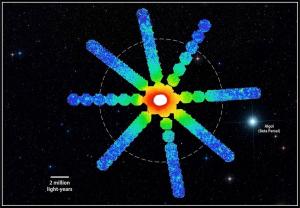Blog
Iron Giant
1 November 2013
 NASA/ISAS/DSS/O. Urban et al., MNRAS
NASA/ISAS/DSS/O. Urban et al., MNRASThe Perseus cluster is a cluster of nearly 200 galaxies about 240 million light years away. It is the advantage of being a large cluster of galaxies at a relatively close distance, so it is often the focus of investigations on the behavior and evolution of galactic clusters. Yesterday in Nature (paywalled, arxiv version here) a new study1 on the Perseus cluster has been released, and the results are very interesting.
The team looked at x-ray scattering off of iron atoms, which they could detect by looking at a specific emission line of iron. Since only iron gives off this particular x-ray emission, a map of the cluster at that particular wavelength gives us a map of the distribution of iron atoms in the cluster. The results can be seen in the figure above.
The dashed circle marks the rough edge of the cluster, and the spokes show the concentrations of iron along different directions, with red being high, green middling, and blew low. As you can see, the central region has the highest concentration, but the green region extends pretty far. There are even pockets of green near the outer regions of the cluster. What this means is that iron is not simply clustered in the galaxies, but is much more uniformly distributed.
The team looked for iron because it is easier to observe than other elements, but iron can only be produced in the cores of stars, just like all “metals” (elements other than hydrogen and helium). So the distribution of iron is also a good measure of the distribution of all metals. And that tells us something about how the universe was seeded with heavier elements.
We’ve long known that “metals” are formed within the cores of stars. When large stars or white dwarfs explode a supernovae, those metals are thrown out into the universe, where they can be used to form other stars and planets. This is sometimes called the seeding process. What we haven’t been clear on is whether this seeding happened earlier or later in the history of the universe. Did the seeding process occur before clusters like Perseus formed? Or did the clusters form first, and seeding largely occur afterward?
The team found that about 60% of the iron distribution is in the outer half of the cluster. If the iron had been seeded after the cluster formed, it wouldn’t be so widely distributed. That means the seeding occurred before the cluster formed. This agrees with other evidence that points to the seeding process reaching a peak around 10-12 billion years ago, with galaxy clusters forming later.
Of course this is an observation of only one cluster. If the early seeding model is correct, one would expect similar clusters will also have a wide iron distribution. It will take further observation to determine if the early seeding model holds, or if the Perseus cluster is an unusual exception.
Werner, Norbert, et al. “A uniform metal distribution in the intergalactic medium of the Perseus cluster of galaxies.” Nature 502.7473 (2013): 656. ↩︎